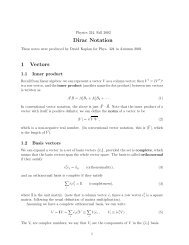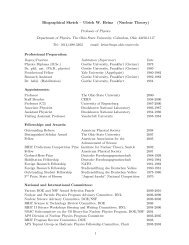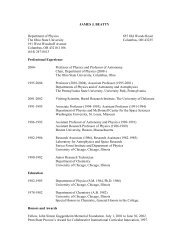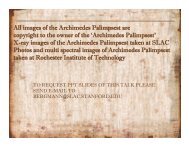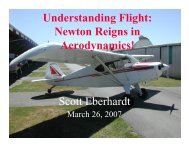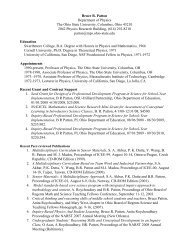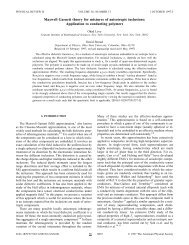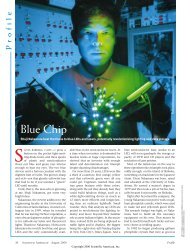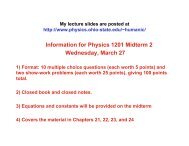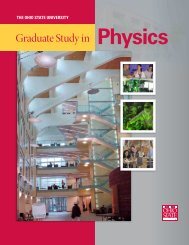Brasil Final Report - Department of Physics - The Ohio State University
Brasil Final Report - Department of Physics - The Ohio State University
Brasil Final Report - Department of Physics - The Ohio State University
Create successful ePaper yourself
Turn your PDF publications into a flip-book with our unique Google optimized e-Paper software.
20<br />
We are currently developing two types <strong>of</strong> curriculum, both <strong>of</strong> which are nationally distributed.<br />
<strong>Physics</strong> by Inquiry is a self-contained, laboratory-based curriculum designed for use by faculty to<br />
prepare precollege (i.e., pre-university) teachers. 6 Tutorials in Introductory <strong>Physics</strong> is intended to<br />
supplement the lectures, laboratory experiments, and textbooks that characterize instruction in a<br />
standard university physics course. 7 Both sets <strong>of</strong> instructional materials are research-based.<br />
In this paper, we discuss the role <strong>of</strong> research in the development <strong>of</strong> curriculum by the <strong>Physics</strong><br />
Education Group. <strong>The</strong> discussion is based on results from a long-term, investigation <strong>of</strong> student<br />
understanding <strong>of</strong> geometrical and physical optics. 8,9 (Other topics could have served the same<br />
purpose.) To give a sense <strong>of</strong> the scope <strong>of</strong> the curriculum in introductory physical optics, the<br />
examples used as illustrations have been drawn from different sub-topics (single-slit diffraction,<br />
double-slit and multiple-slit interference).<br />
<strong>The</strong> results from the part <strong>of</strong> the investigation discussed in this paper involved undergraduate and<br />
graduate students at our university. <strong>The</strong> undergraduates came from several courses: introductory<br />
calculus-based and algebra-based physics, sophomore-level modern physics, and junior-level<br />
quantum mechanics. <strong>The</strong> latter two groups consisted mostly <strong>of</strong> physics majors. <strong>The</strong> graduate<br />
students were enrolled in a weekly teaching seminar required for all teaching assistants in our<br />
physics department. Although none <strong>of</strong> the data were expressly collected from precollege teachers,<br />
some prospective high school teachers were included in almost all <strong>of</strong> the groups. Results from other<br />
topics indicate that their responses tend to be similar to those <strong>of</strong> science and engineering majors. 10<br />
IDENTIFICATION OF WHAT STUDENTS CAN AND CANNOT DO<br />
To be able to improve instruction in an efficient and cumulative manner, a systematic approach<br />
is necessary. Just as physicists do in any investigation, we focus attention on the phenomenon<br />
being studied. Extrapolating on the basis <strong>of</strong> one’s own ideas and experience can be very misleading.<br />
<strong>The</strong> proper place to begin is to determine what students can and cannot do. This approach is<br />
illustrated by the examples that follow.<br />
Single-slit diffraction<br />
<strong>The</strong> first two questions on diffraction described below were administered on examinations in the<br />
introductory calculus-based physics course at the <strong>University</strong> <strong>of</strong> Washington. <strong>The</strong> questions pose<br />
301–315 (1991) and “Guest Comment: How we teach and how students learn—A mismatch?” ibid. 61 295–298<br />
(1993).<br />
6<br />
L.C. McDermott and the <strong>Physics</strong> Education group at the <strong>University</strong> <strong>of</strong> Washington, <strong>Physics</strong> by Inquiry, Vols.<br />
I and II (John Wiley & Sons, Inc., New York, N.Y., 1996).<br />
7 L.C. McDermott, P.S. Shaffer, and the <strong>Physics</strong> Education group at the <strong>University</strong> <strong>of</strong> Washington, Tutorials in<br />
Introductory <strong>Physics</strong>, Preliminary Edition (Prentice Hall, Upper Saddle River, N.J., 1998).<br />
8<br />
For articles by our group on geometrical optics, see P.R.L. Heron and L.C. McDermott, “Bridging the gap<br />
between teaching and learning in geometrical optics: <strong>The</strong> role <strong>of</strong> research,” Opt. & Phot. News 9 (9), 30–36 (1998); K.<br />
Wosilait, P.R.L. Heron, P.S. Shaffer, and L.C. McDermott, “Development and assessment <strong>of</strong> a research-based tutorial<br />
on light and shadow,” Am. J. Phys. 66, 906–913 (1998); F.M. Goldberg and L.C. McDermott, “Student difficulties in<br />
understanding image formation by a plane mirror,” Phys. Teach. 24 472–480 (1986); and F.M. Goldberg and L.C.<br />
McDermott, “An investigation <strong>of</strong> student understanding <strong>of</strong> the real image formed by a converging lens or concave<br />
mirror,” Am. J. Phys. 55 108–119 (1987).<br />
9<br />
For articles by our group on physical optics, see B.S. Ambrose, P.S. Shaffer, R.N. Steinberg, and L.C.<br />
McDermott, “An investigation <strong>of</strong> student understanding <strong>of</strong> two-source interference and single-slit diffraction,” Am. J.<br />
Phys. 67 146–155 (1999) and K. Wosilait, P.R.L. Heron, P.S. Shaffer, and L.C. McDermott, “Addressing student<br />
difficulties in applying a wave model to the interference and diffraction <strong>of</strong> light,” Phys. Educ. Res., Am. J. Phys. Suppl.




